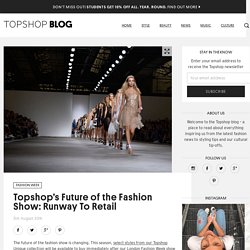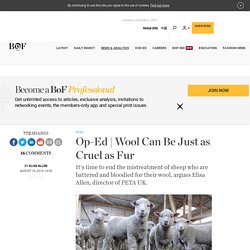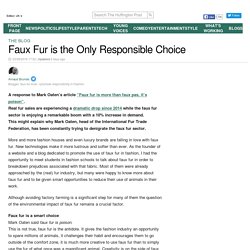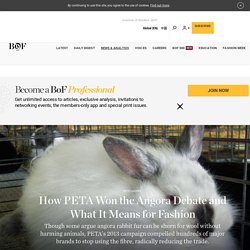

S Future of the Fashion Show: Runway To Retail - Topshop Blog. Fashion Week The future of the fashion show is changing.

This season, select styles from our Topshop Unique collection will be available to buy immediately after our London Fashion Week show this Sunday 18th September at Old Spitalfields Market. It’s all part of a major shift happening in the fashion industry. In our fast-moving digital world, the idea of the traditional catwalk model has become outdated: why see a collection you won’t be able to buy for another four months? This is the question more and more designers are addressing with a ‘see-now, buy-now’ approach, with big names like Tom Ford, Vetements, Tommy Hilfiger and Matthew Williamson also introducing the runway to retail model in the last year. So what Topshop Unique ‘season’ will you be buying in September? Jacqui Markham, Topshop’s Global Design Director, adds, “It’s been an exciting period of trial and experimentation for us all, from conception, through to design and production.
Wool Can Be Just as Cruel as Fur. LONDON, United Kingdom — The fashion industry is shifting.

Led by a social and eco-conscious generation, today's consumers are increasingly demanding to know about the journey their garments took before arriving on the shop floor. It's this awareness that's caused a great many to ditch fur, exotic skins, and angora — after all, who can really feel good strutting around in a fur coat once you've seen images of foxes living alone and petrified in tiny cages and having their skin peeled off?
Yet, somehow wool seems to have escaped such scrutiny — until now. Over the last year, PETA has released several video exposés of the wool industry, documenting cruelty at more than 30 farms and wool sheds across three continents, including Australia — the world's largest exporter of wool. Investigators also saw sheep penned and denied food and water the night before being shorn, in part to weaken them so they would put up minimal resistance. Elisa Allen is director of PETA UK. Related Articles: Faux Fur is the Only Responsible Choice. A response to Mark Oaten’s article “Faux fur is more than faux pas, it’s poison”.

Real fur sales are experiencing a dramatic drop since 2014 while the faux fur sector is enjoying a remarkable boom with a 10% increase in demand. This might explain why Mark Oaten, head of the International Fur Trade Federation, has been constantly trying to denigrate the faux fur sector. More and more fashion houses and even luxury brands are falling in love with faux fur. New technologies make it more lustrous and softer than ever. As the founder of a website and a blog dedicated to promote the use of faux fur in fashion, I had the opportunity to meet students in fashion schools to talk about faux fur in order to breakdown prejudices associated with that fabric.
Although avoiding factory farming is a significant step for many of them the question of the environmental impact of faux fur remains a crucial factor. We've Already Used Up Earth's Resources For The Year. How PETA Won the Angora Debate and What It Means for Fashion. NEW YORK, United States — In the spring of 2016, a group of top-tier fashion executives convened in midtown Manhattan for a closed-door meeting.

The conversation centred on the treatment of animals and the ethics policies they had in place. It was clear that many brands felt more pressure than ever to cooperate with the People for the Ethical Treatment of Animals — the international non-profit organisation widely known as PETA. “Look at what PETA did to angora,” one executive said. “They virtually wiped it out.” Indeed, in 2013, PETA took on the trade in angora rabbit fur in what proved to be one of its most successful campaigns, releasing a video of a rabbit in China — the world's top producer of angora wool — being tortured and mutilated, its fur hand-plucked from its body. Indeed, sales of angora rabbit wool — not to be confused with the fleece of the angora goat, also known as mohair — have decreased dramatically since PETA launched its campaign. Related Stories: